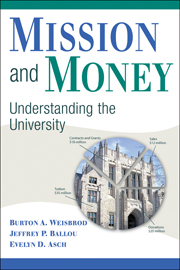Book contents
- Frontmatter
- Contents
- Illustrations
- Preface
- 1 An Introduction to the Higher Education Industry
- 2 The Higher Education Business and the Business of Higher Education – Now and Then
- 3 Is Higher Education Becoming Increasingly Competitive?
- 4 The Two-Good Framework: Revenue, Mission, and Why Colleges Do What They Do
- 5 Tuition, Price Discrimination, and Financial Aid
- 6 The Place of Donations in Funding the Higher Education Industry
- 7 Endowments and Their Management: Financing the Mission
- 8 Generating Revenue from Research and Patents
- 9 Other Ways to Generate Revenue – Wherever It May Be Found: Lobbying, the World Market, and Distance Education
- 10 Advertising, Branding, and Reputation
- 11 Are Public and Nonprofit Schools “Businesslike”? Cost-Consciousness and the Choice between Higher Cost and Lower Cost Faculty
- 12 Not Quite an Ivory Tower: Schools Compete by Collaborating
- 13 Intercollegiate Athletics: Money or Mission?
- 14 Mission or Money: What Do Colleges and Universities Want from Their Athletic Coaches and Presidents?
- 15 Concluding Remarks: What Are the Public Policy Issues?
- Appendix
- References
- Index
4 - The Two-Good Framework: Revenue, Mission, and Why Colleges Do What They Do
Published online by Cambridge University Press: 17 July 2009
- Frontmatter
- Contents
- Illustrations
- Preface
- 1 An Introduction to the Higher Education Industry
- 2 The Higher Education Business and the Business of Higher Education – Now and Then
- 3 Is Higher Education Becoming Increasingly Competitive?
- 4 The Two-Good Framework: Revenue, Mission, and Why Colleges Do What They Do
- 5 Tuition, Price Discrimination, and Financial Aid
- 6 The Place of Donations in Funding the Higher Education Industry
- 7 Endowments and Their Management: Financing the Mission
- 8 Generating Revenue from Research and Patents
- 9 Other Ways to Generate Revenue – Wherever It May Be Found: Lobbying, the World Market, and Distance Education
- 10 Advertising, Branding, and Reputation
- 11 Are Public and Nonprofit Schools “Businesslike”? Cost-Consciousness and the Choice between Higher Cost and Lower Cost Faculty
- 12 Not Quite an Ivory Tower: Schools Compete by Collaborating
- 13 Intercollegiate Athletics: Money or Mission?
- 14 Mission or Money: What Do Colleges and Universities Want from Their Athletic Coaches and Presidents?
- 15 Concluding Remarks: What Are the Public Policy Issues?
- Appendix
- References
- Index
Summary
Amid the obvious complexity of schools' activities and the equally obvious differences between research universities and liberal arts colleges, and between for-profit and nonprofit schools, there is a fundamental simplicity. Every school does two things: it raises revenue and it spends it. It spends money to pursue its mission and it raises revenue to finance those expenditures. Every school of every form must generate revenue to advance its goals, however different those goals may be.
These two elements of each school's behavior – deciding how it can raise money and how it should spend it – provide a valuable starting point for examining how the various types of schools determine such elements as tuition and financial aid policy, how much to spend on fundraising, how much legislative lobbying to do for governmental grants, which level of intercollegiate athletics to play, how to capitalize on a strong brand-name reputation, how much to spend on recruiting students, whether to lease or buy classroom space, and what to look for in a new president. As we investigate these and other aspects of collegiate activities we can be guided by thinking of schools as “two-good firms” – choosing which methods to use for raising money and which activities to spend the money on. Both kinds of activities are affected by the school's competitive position as it considers how to define its goals and how to finance them.
- Type
- Chapter
- Information
- Mission and MoneyUnderstanding the University, pp. 58 - 76Publisher: Cambridge University PressPrint publication year: 2008

